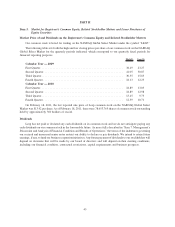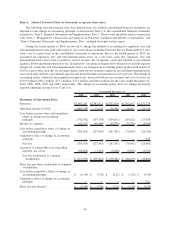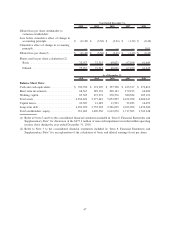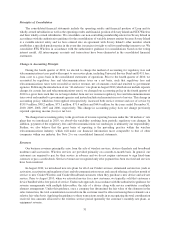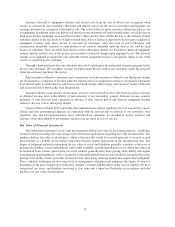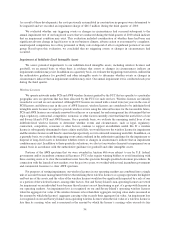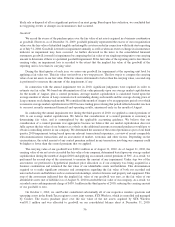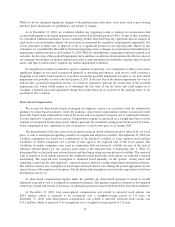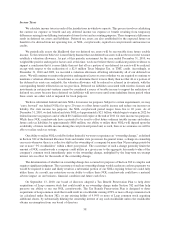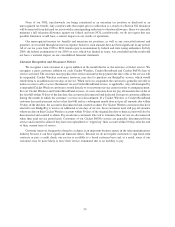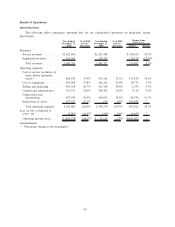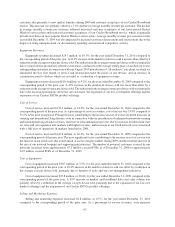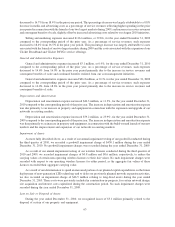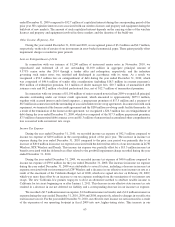Cricket Wireless 2010 Annual Report Download - page 61
Download and view the complete annual report
Please find page 61 of the 2010 Cricket Wireless annual report below. You can navigate through the pages in the report by either clicking on the pages listed below, or by using the keyword search tool below to find specific information within the annual report.value. Any required impairment loss is recorded as a reduction in the carrying value of the relevant wireless license
and charged to results of operations. As a result of the annual impairment test of wireless licenses, we recorded
impairment charges of $0.8 million and $0.6 million during the years ended December 31, 2010 and 2009,
respectively, to reduce the carrying values of certain non-operating wireless licenses to their estimated fair values.
No impairment charges were recorded for our operating wireless licenses as the aggregate fair value of these
licenses exceeded the aggregate carrying value.
The valuation method we use to determine the fair value of our wireless licenses is the market approach. Under
this method, we determine fair value by comparing our wireless licenses to sales prices of other wireless licenses of
similar size and type that have been recently sold through government auctions and private transactions. As part of
this market-level analysis, the fair value of each wireless license is evaluated and adjusted for developments or
changes in legal, regulatory and technical matters, and for demographic and economic factors, such as population
size, composition, growth rate and density, household and disposable income, and composition and concentration of
the market’s workforce in industry sectors identified as wireless-centric (e.g., real estate, transportation,
professional services, agribusiness, finance and insurance). The market approach is an appropriate method to
measure the fair value of our wireless licenses since this method values the licenses based on the sales price that
would be received for the licenses in an orderly transaction between market participants (i.e., an exit price).
As more fully described above, the most significant factor used to determine the fair value of our wireless
licenses is comparable sales transactions. Other factors used in determining fair value include developments or
changes in legal, regulatory and technical matters as well as demographic and economic factors. Changes in
comparable sales prices would generally result in a corresponding change in fair value. For example, a 10% decline
in comparable sales prices would generally result in a 10% decline in fair value. However, a decline in comparable
sales would likely require further adjustment to fair value to capture more recent macro-economic changes and
changes in the demographic and economic characteristics unique to our wireless licenses, such as population size,
composition, growth rate and density, household and disposable income, and the extent of the wireless-centric
workforce in the markets covered by our wireless licenses. Spectrum auctions and comparable sales transactions in
recent periods have resulted in modest increases to the aggregate fair value of our wireless licenses as increases in
fair value in larger markets were slightly offset by decreases in fair value in markets with lower population densities.
In addition, favorable developments in technical matters such as spectrum clearing and device availability have
positively impacted the fair value of a significant portion of our wireless licenses. Partially offsetting these increases
in value were demographic and economic-related adjustments that were required to capture current economic
developments. These demographic and economic factors resulted in a decline in fair value for certain of our wireless
licenses.
As a result of the valuation analysis discussed above, the fair value of our wireless licenses increased by
approximately 13% from September 2009 to September 2010 (as adjusted to reflect the effects of our acquisitions
and dispositions of wireless licenses during the period). In connection with our 2010 annual impairment test, the fair
value of our and Savary Island’s wireless licenses significantly exceeded their carrying value. The aggregate fair
value of our and Savary Island’s individual wireless licenses was determined to be $2,734.7 million, which when
compared to their respective aggregate carrying value of $1,920.0 million, yielded significant excess fair value.
In connection with our 2010 annual impairment test, the aggregate fair value and carrying value of our and
Savary Island’s individual operating wireless licenses was determined to be $2,518.2 million and $1,772.2 million,
respectively. If the fair value of our and Savary Island’s operating wireless licenses had declined by 10% in such
impairment test, we would not have recognized any impairment loss. In connection with our 2010 annual
impairment test, we determined that the aggregate fair value and carrying value of each of our and Savary
Island’s individual non-operating wireless licenses was $216.5 million and $147.8 million, respectively. If the fair
value of our and Savary Island’s non-operating wireless licenses had each declined by 10% in such impairment test,
we would have recognized an impairment loss of approximately $1.0 million.
We evaluated whether any triggering events or changes in circumstances occurred subsequent to our 2010
annual impairment test of our wireless licenses which indicate that an impairment condition may exist. This
evaluation included consideration of whether there had been any significant adverse change in legal factors or in our
business climate, adverse action or assessment by a regulator, unanticipated competition, loss of key personnel or
55


